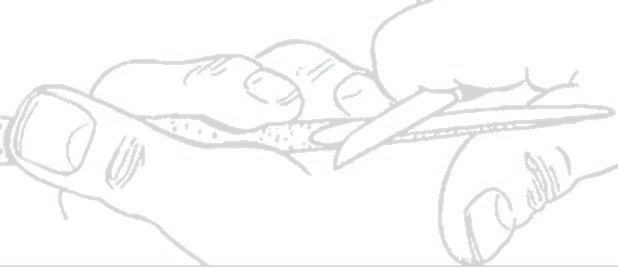STEP 1
STEP 2
The sketch is the same size as what the whittled piece will be. Since the baby elephant is kind of fat, I selected a piece of 3/4 inch thick Basswood on which to trace the pattern. I choose to position the pattern on the Basswood so that the wood grain would not make the small trunk tip weak. For this piece, the grain should run tail to trunk tip. After tracing the pattern, use the scroll saw to cut out the blank. If there is any possibility that I may want to whittle more than one, I also trace the pattern onto a thin piece of plywood and scroll saw it out to be used for a future pattern.
STEP 2
Using a pencil, lightly draw the detail on the sides of the blank. If you think you don't need to draw these details go for it, because it will make finishing the piece easier....
STEP 3
First cuts are stop cuts at the edges of the top of the blank, where the head joins the body. Make this stop cut on each side of the head, where it joins the body.
NOTE: Notice that I am not wearing gloves nor a thumb guard. Nor do I have a wood holding device or a handle on the blank. This may make some cringe working this close to a very sharp knife. If you have any reservations at all about using a knife without protection, by all means wear a glove and thumb guard. I try to employ knife cutting techniques that prevent me from nicking or cutting myself. I will mention these techniques in the following steps.
STEP 3
STEP 4 Remove a chip at each of these stop cuts. Go for a small chip. Trying to cut large chunks out will usually result in the knife spliting the wood and perhaps cutting you. I like to make a cut on one side and then immediately make the same cut on the other side. This will help with symetry, and balance of the piece.
STEP 4
STEP 5 Begin to round the head. Determine the direction of the grain with a first thin/small cut. If your knife digs in and seems like it will split the wood you are cutting against the grain. Reverse the blank in your hand and cut in the opposite direction with the grain. Remove thin slivers of wood rather then thick ones. When cutting across the grain, remove small chips of wood. For a small whittling these chips should be about the size of a grain of rice, or flake of oat meal. A sharp knife will make this much easier.
STEP 5
STEP 6 Begin to narrow the elephants trunk. Begin these knife cuts at the area where the front legs meet the head/trunk.
NOTE It's aways a good idea to position the thumb on your wood holding hand below the top edge of the wood. This offers protection when cutting towards your self. I also have found that it helps to make very thin slices and to "roll" the knife blade kind of "up" away from the wood when slicing.
STEP 6
STEP 7 Next, make a stop cut defining the elephants ear.
NOTE: Start the stop cut at the top of the head and make the cut half way down towards the bottom of the ear, Then reverse the block of wood in your hand and make the rest of the stop cut from the bottom of the ear. This technique will prevent you from "pulling" the knife blade over the edge of the wood when completing the stop cut. This will prevent cutting yourself, because there is usually a finger over the edge of the wood. The stop cuts should meet in the center.
STEP 7 B
STEP 8 Began to round off the elephants back. When you get to the stop cuts that define the ears cut down to the stop cuts so that ears stand out from the body a bit (see step 11 photo).
STEP 8
Step 9 Begin to round off the hind quarters, and legs
STEP 9
STEP 10 Continue rounding off the back and hind quarters. The top of the back should be narrower than the belly area. Be sure to leave a bit of the elephants tail at the center of the rump.
STEP 10
STEP 11 Round the front legs.
STEP 11
STEP 12 Make a stop cut at the rear legs angles up into the belly, to separate the belly from the upper leg area.
NOTE: When make this stop cut hold your knife firmly/steady and "move" the wood into the blade. A "rocking" motion works well.
STEP 12
STEP 13 Remove a chip from the back of the elephants front legs to the stop cut at the front of the back legs. After this chip is removed, round the belly area between the elephants back and front legs.
STEP 13
STEP 14 Complete rounding the elephants back, head, trunk, rump, and legs. Remove chips and slivers until all of the flat (sawed) areas are gone.
STEP 15 This step is optional. But for those who want to, this step separates the elephants ears at the top of the head. Make a stop cut at the center of the head running from the front to the back of the head. Use the knife to remove a V shaped chip from this area.
STEP 15
STEP 16 Finishing the baby elephant. In the example photo I did not separate the ears and it still looks like a baby elephant. I lightly sanded the piece and applied acrylic paint.

















No comments:
Post a Comment
click here to comment on this post!